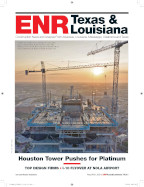 Probe studies truss reinforcement.
|
In an Oct. 23 update, NTSB says it is still “in the midst of a complete and thorough analysis.” But forensic engineers working on the probe already have some ideas of what caused the 40-year-old bridge to suddenly collapse. Several sources suggest they are looking at the stress that seized bearings, construction loads, truss corrosion and hot summer weather placed on gusset plates that were underdesigned from the beginning.
The federal team includes Northbrook, Ill.-based Wiss, Janney, Elstner Associates Inc. It was hired as the state’s investigator under a $2-million contract but quickly took on a coordinating role. In August, The New York Times reported that WJE’s team discovered problems with gussets after reviewing the 40-year-old bridge’s design drawings.
The review has gone deeper. Last month, the Star Tribune reported that investigators, quoted anonymously, were focusing on corrosion, summer heat, broken bearings and three 1⁄2-in. to 1-in.-thick gusset plates at the southern end of the bridge at locations L9, U10 and L11.
One investigator confirmed the accuracy of the news reports but declined to discuss the probe with ENR, citing a federal confidentiality agreement and calling the silence policy “a disservice to the engineering community.” A spokesman for NTSB says the agency would issue an “urgent recommendation” if it discovers system-wide problems. So far, it has not made any recommendations related to the accident, which killed 13 people.
The probe is expected to take a year to 18 months. Meanwhile, work on the new bridge, including drilling a test shaft and pile driving, is getting under way.
ngineers probing the Aug. 1 bridge disaster in Minneapolis are anxious to disclose their findings, but federal officials with the National Transportation Safety Board are just as eager to keep them quiet until the review is complete.

Post a comment to this article
Report Abusive Comment